
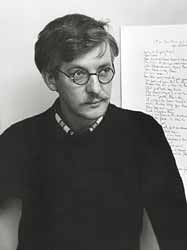
Ravenna, Seattle—June, 1965
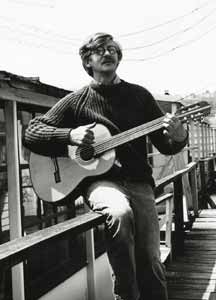
July, 1967
In a landscape that desperately needs color why do the flowers stay so close to the ground? You meet them with surprise hidden in the pale grasses.
From 1964-1967, Robert was poetry program director for Lorenzo Milam’s KRAB-FM in Seattle. There, he conducted live interviews with such poets as Robert Bly, Galway Kinnell, and Lawrence Ferlinghetti. In 1968, he published Bly, Kinnell, and Pablo Neruda, among others, in the first and only issue of the Sullivan Slough Review, an ambitious magazine that is now a collector’s item.
The seventies found Robert living the life of an artist. He was often broke, but always true to his calling. He sold single calligraphed poems and an occasional work of art in Seattle, shot passionate games of pool in her taverns, filled notebooks with poems, and discovered the work of Karl Gustav Jung. Jung’s archetypal imagery fascinated him and he began a long series of gouache mandala images on paper that were shown in several Seattle galleries, including Richard White, Second Storey, Polly Friedlander, and the Seattle Art Museum.
During that same time, Robert discovered the Autoharp, which became his lifelong instrument. Most of his poetry readings included at least a few songs with Autoharp accompaniment.
On a trip to Shi-Shi beach with artist Charles Krafft in the early seventies, a vision came to him of a pyramidal shaped cabin behind the huge log drifts at the mouth of Petroleum Creek. Over the next few years, he and many friends fashioned two-inch thick drift boards of teak, cedar, and fir into a beautiful shelter with a beach-stone fireplace. Many survivors of that era fondly remember the glorious isolated beach, the vegetarian cuisine and the high times. Later, in gratitude for those days and the place, Robert was active in the movement to incorporate Shi-Shi into Olympic National Park. After that was accomplished, of course, the shelter was dismantled.
But, his passion for wilderness was ignited, and he turned to an earlier discovery of abandoned gill-netter shacks in Fishtown, on the North Fork of the Skagit River. Krafft had already moved there, and soon there was a thriving community of artists, including calligrapher-bookman Steve Herold, poet-artist Paul Hansen and sculptor-architect Bo Miller.
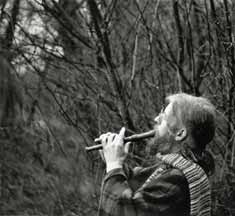
Robert opted for a remote shack just downstream on Ship Creek (which he called Disappearing Lake due to the tidal action at the mouth of the river). There, he crafted another aesthetically pleasing shack filled with the simple beauties of stone, wood, pottery, and paper art. It became the center for his work for the next eleven years. As always, notebooks filled up with poetry, and from those efforts came two beautiful chapbooks in collaboration with printer Rusty North of Sagittarius Press, Port Townsend (Why I am Singing for the Dancer, 1979, and How the Dancer is Carried Into the Hall of Light, 1982).
In 1982, he hosted Kenneth Rexroth at a poetry reading in La Conner, and published another chapbook with one long poem for Rexroth, entitled This Flower (The Great Blue Heron Society, La Conner, 1982). Perhaps prophetically, he attached an addendum to this exquisite work entitled “One More for Good Measure.”
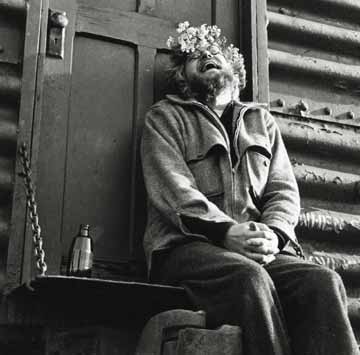
Maybe exalted gestures will be retrieved in our time. Maybe our grandchildren will go through our trunks and boxes and be amazed.
The most profound statement of his years at Disappearing Lake was Shack Medicine (Tangram Press, 1990, and Poet’s House Press, 1992). In “A Note on the Setting” from this book, he said, “Out on the river you know you are in the midst of a great creation. You see the old work and the new work side by side; the ancient migration routes of all the birds, and the slow building of silt and soil in the estuary; a small grassy island, for instance, that wasn’t there last year and that, in a few seasons, will grow new willow for the blackbirds and the beavers.”
Here, too, he discovered the old Chinese and Japanese “hermit poets,” and produced new versions of finely honed poetry from other translations. Robert calligraphed many such poems on “wind letters” over the next two decades, a practice he followed until the end of his life.
In 1984, his book, Ish River (North Point Press, San Francisco, 1983), won the Washington State Governor’s Award for best new book of poetry. Here are poems written longingly about his family, grieving, and sometimes bitter, reflections of life in the towns and cities of Washington State, and tender reminiscences of love celebrated and lost. After a short hiatus and a private showing of new paintings in California, at the home of friends in Point Reyes and at Woodacre, he was diagnosed with diabetes. Soon after, another chapbook was published. As Though the Word Blue Had Been Dropped Into the Water (Sagittarius Press, Port Townsend, 1986), consisted of eight “healing poems,” including “Like a Boat Drifting.”
Like a boat drifting, sleep flows forward on the deep water of dreams. Drifts and drifts... until, finally the bottom falls out of knowledge. In the fragrant mist of dawn the rower wakes, picks up the oars, sets them, and begins to row. All night he labored in his dream to be born like a song in the mouth of God.
Back in La Conner, after hospitalization, he found shelter with many friends: Jim and Janet Smith, Barbara Cram, Alan Olsen and Charlotte Underwood. There, Robert Sund was active in a group of artists, musicians, and poets who formed the La Conner Arts Foundation (LAF), which worked with the town to restore Maple Hall for use as a community center. He calligraphed flyers for art show openings, and painted posters for the film society’s movies.
In perhaps the most memorable mayoral election in La Conner’s history, Robert declared himself a candidate in 1984, and “stirred the political soup.” He did not win, but the effort brought an eloquent voice into the arena, and the politicians to the edges of their seats.
Some of Robert’s most joyful days were spent working with Washington’s young people as “Poet in the Schools” at Skagit Valley College (1969), Seattle Public Schools (1973), and La Conner Elementary School (1976-77). He also worked with Christine Wardenburg in their “Patterns in Nature” summer camp series at Burlington Little School (1987-1989). This program won an award of excellence from the Washington Alliance of Art Educators in October of 1988.
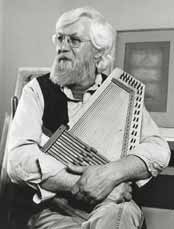
The Nelson family of La Conner gifted him a small corner lot adjacent to their lumberyard, which he latter traded for land on La Conner’s hill. After selling that, he moved to Anacortes and lived on the monthly proceeds and social security income.
He found a tiny cottage in the middle of the Flounder Bay Boatyard, and kind landlords in Bob and Erica Pickett. Here, over the remaining years of his life, he created another charming retreat. The gardens held a surprise in every corner—an interesting rock and shell grouping here, a perfectly placed, carefully selected stone there, with lovely board fences, a beautiful gate, and pampered flowers and plants everywhere. Here, he wrote the Garden Poems, which will be republished in the near future as broadsides by the “Poet’s House Press.”
Robert found a musical soul mate and mentor in guitarist Brad Killian, and their guitar-autoharp duets were delightful to hear. Recently, he teamed up with calligrapher Ora Mae Cunningham to establish the Ink River Studio in old town Anacortes. They laid plans for workshops and classes there, and were about to embark on them when he fell ill this past spring.
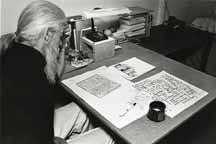
Although he was private about it, Robert was a very religious man. He put great faith in the teachings of the Buddha, although he recognized the universal truth at the core of all religions. He revered his teacher, Deschung Rinpoche (deceased), cofounder of the Sakya Monastery in Seattle. In a letter to the Monastery just shortly before his death, he wrote, “In the early 1970’s in Seattle Deschung Rinpoche gave me my Tibetan name. Ever after, I have tried to honor his being, his generous spirit, and his kindness to me.”
Robert’s last will and testament created a trust, with an eleven member board of friends, to care for his work, publish it, and someday build his dream “Poet’s House,” a place for visiting artists to live and create poetry, calligraphy and pottery.
Robert Sund passed away at 12:40 AM on September 29, 2001, in Anacortes, Washington, while his beloved Ish Rivers teemed with spawning salmon, their spent bodies littering the banks of small creeks where they’ve not been seen in years. Family, and a grand circle of friends throughout the nation survive him. His thoughts for them were put succinctly in an unpublished poem from the Shi-Shi years:
Friends make us fuller. When friends leave, their light stays behind. It is like the blue sea that supports the white breakers that come and go.
No matter how far I go I long to return and be with friends. It is never the same fire I left, but beneath it are the ashes of all our meetings that have gone before.
Recollections Compiled by Arthur Greeno Photographs of Robert Sund courtesy of Mary Randlett All poems are copyright © by Robert Sund
